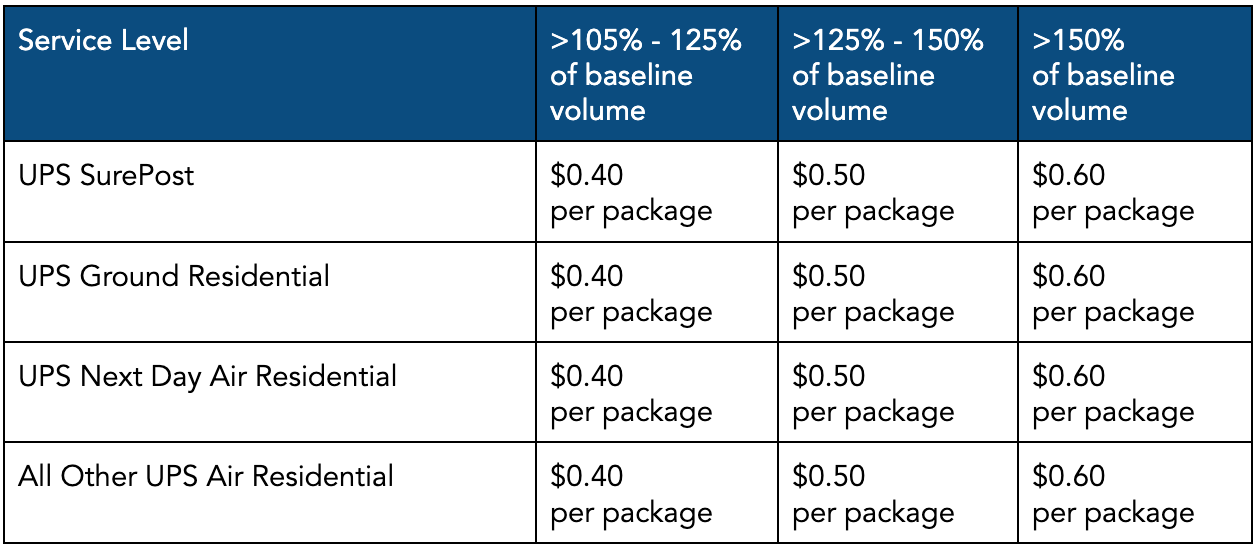FedEx, UPS Extend Peak Surcharges Indefinitely
Peak surcharges for UPS and FedEx are here to stay well into the new year. Instead of being allowed to expire as holiday demand fades, these additional charges remain “until further notice,” both carriers have announced.
Historically, carriers have used these charges to pass their costs onto customers as parcel volume increased at year’s end.
The extensions come as UPS and FedEx cope with lower fuel costs and a decreased package volume over the past few months. In turn, the carriers are finding new ways to maintain their profit margins by charging their customers in additional ways.
While it’s possible FedEx and UPS could decide to discontinue these surcharges, they will likely become permanent with no additional announcements.
The extended surcharges will apply to heavy and bulky packages – in addition to the hefty oversized, and additional handling surcharges already levied on such packages.
What UPS Shippers Need to Know About Extended Demand Surcharges
UPS is extending peak-season surcharges for packages that fit the definition of a “large package” and those requiring additional handling. The extended charges are in effect “until further notice” with no end date.
These surcharges apply in addition to all other charges, which means those who ship packages subject to these added costs will get hit twice – once with the standard fee, then again with the demand surcharge.
It’s also worth noting the subtle name changes to this fee over the years have pointed toward it becoming a permanent line item. Originally called peak-season surcharges, UPS rebranded the charges as “Peak/Demand” surcharges for the 2021 season before rebranding the costs again as “Demand Surcharges.”
In addition, enterprise-level shippers who experience demand spikes will see additional per-package fees when they ship more than 105% of their baseline volume.
By UPS’s definition, this surcharge applies to shippers billed for more than 20,000 packages in any week after October 2021 and use Air Residential, Ground Residential, or SurePost services.
The amount of per-package fees depends on the extent of the spike in volume and service level.
UPS will determine the shipper’s baseline by measuring the average weekly shipping volume during set periods. Per UPS:
The “Baseline” volume is the customer’s average weekly volume for the applicable service level for June 2022 (Jun. 5, 2022, through Jul. 2, 2022). If the customer’s average weekly volume for the applicable service level from Sept. 4, 2022, through Oct. 2, 2022 is less than 80% of its average weekly volume from Jun. 5, 2022 through Jul. 2, 2022, as determined by UPS in its sole and unlimited discretion, then customer’s average weekly volume from Sept. 4, 2022 through Oct. 2, 2022 will be used as the Baseline volume.
What FedEx Shippers Need to Know About Extended Peak Surcharges
FedEx is also making peak demand surcharges permanent – reversing its original announcement of 2022 season rates.
Back in August 2022, FedEx announced its peak season rates. As has been typical of the carrier, additional surcharges took effect in September and gradually increased as the holiday shipping season intensified before ending in January 2023.
In December, the carrier announced that the extra surcharges would remain in effect for oversized packages and those requiring additional handling until further notice. However, the per-package blanket charges, unauthorized ground package and residential delivery fees expired on Jan. 15.
Per FedEx, the extended surcharges are as follows:
Like the UPS surcharges, these eternal peak demand surcharges apply in addition to the standard slate of accessorial fees. So, oversize packages, or those requiring additional handling, will get hit with double the costs – the standard surcharge and the extra “peak” demand charge.
How to Mitigate the Impact on Your Shipping Spend
Enterprise-level shippers and those who send a large amount of heavy and bulky parcels will see the most significant impact from this change. To mitigate the impact on your bottom line, we have two critical pieces of advice:
Understand your shipping profile: This means knowing your data inside and out to answer questions such as, “How many packages do you typically ship?” “Which times of year do you ship a higher volume of packages?” “What are the weights and measurements of your shipments?” and “Which service levels do you use most often?”
Know how surcharges impact your shipping spend: Once you understand your shipping profile, you can accurately estimate the effect on your bottom line.
Bringing in a trusted partner can also help you mitigate the impact of ever-multiplying surcharges. In addition, your trusted partner can help analyze your shipping data and benchmark your carrier pricing, so you can understand how your rate compares to others and uncover specific opportunities to save on your overall shipping spend.
We founded AUSPI GROUP on the importance of partnership and the desire to empower businesses like yours with market insights and industry knowledge to lower shipping costs.
If you’re interested in gaining greater control of your parcel spend, let’s talk.
Our zero-risk, success-based services will give you the analytics and reporting to manage your spend, gain insights, identify trends, find efficiencies, and detect ways to save.



